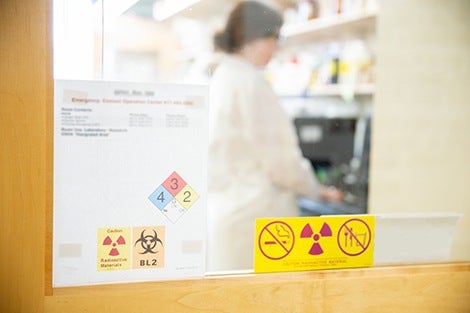Smarter tracking system expected to reduce chemical waste and save time and money
August 1, 2018 – Research labs across Harvard University contain tens of thousands of chemicals, from liquid solutions to compressed gases to radioactive materials to biological agents. It’s a daunting task to keep track of all those chemicals, but now the information technology (IT) team at Harvard T.H. Chan School of Public Health is working with others across the University on a new chemical inventory system.
Under the new “Clever Chemical” project, each chemical container will get a barcode and each lab will be equipped with a barcode reader so that lab workers can scan in new chemicals when they arrive. In addition, the system known as LabPoint, used for creating door signs listing the chemicals present in each lab—crucial information for emergency personnel—will be upgraded. The planning team hopes that these improvements will help labs manage their inventory and share chemicals across labs, and ultimately improve safety and sustainability.
Clever Chemical was one of seven projects that received support last year from the President’s Administrative Innovation Fund, which aims to foster outside-the-box administrative improvements and collaboration across Harvard. The 18-member Clever Chemical team includes staff from Harvard Chan School’s IT department, from Harvard University’s Environmental Health & Safety (EH&S) department, and from other Harvard units that will benefit from the new system, such as the John A. Paulson School of Engineering and Applied Sciences, the Faculty of Arts and Sciences, and other departments and schools with lab research. The team was formed at the suggestion of Fund managers after teams from both Harvard Chan School and EH&S submitted proposals last spring with similar goals.
Multiple benefits
“Getting a project like this funded is really exciting,” said Kevin Wnek, manager of web and application development at Harvard Chan School and one of the project leaders of Clever Chemical. “There’s enormous potential benefit for our school and community.”
Wnek, who developed LabPoint a dozen years ago, said the project has the potential to save the University hundreds of thousands of dollars each year and reduce environmental impact, mostly by reducing chemical waste. In addition, the new system is expected to provide comprehensive, accurate information about chemical locations and quantities and facilitate the sharing of chemicals across labs.
“If your lab runs out of something, the new system could provide an easy way to find out if someone down the hall has what you need,” said Wnek.
Kathryn Kaminski, director of Central EH&S Systems and Programs, who served as a co-leader of the Clever Chemical team, said that the system will provide other benefits, such as improving safety and regulatory compliance and identifying opportunities for green chemistry—switching to less toxic chemical alternatives—or solvent recycling.
The project is also expected to:
- Save researchers time because scanning barcodes means not having to document chemical information manually.
- Reduce energy use by tailoring lab ventilation to actual chemical usage.
- Reduce chemical over-ordering and the resulting chemical waste from unused expired chemicals.
- Make it possible to keep historical data about chemical inventories, enabling lab workers to track costs and usage from year to year.
- Enable the use of email reminders for re-ordering chemicals.
The new chemical tracking system and the revised LabPoint door placarding system will be piloted over the next few months, Kaminski said. Once the team is satisfied with how the systems are working, then additional planning can begin for a possible University-wide rollout.
photo: Nilagia McCoy
